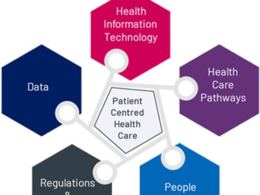MIT Sloan Management Review
Beth Stackpole
Jun 29, 2021
From the board room to the conference room, the mantra is data-driven decision-making — the idea of harnessing powerful computing resources, advanced analytics, and burgeoning data stores to augment human brain power and initiate smarter decisions.
Yet for all the talk and corporate budgets directed to data initiatives, there has been disappointment in analytics programs.
An Accenture survey found that only 32% of companies reported realizing tangible and measurable value from data.
It begs the question: Why are such substantial efforts yet to produce measurable results?
Bart de Langhe and Stefano Puntoni may have the answer, explored in a new MIT Sloan Management Review webinar and in the article “ Leading with decision-driven data analytics.”
De Langhe and Puntoni contend that most companies take a backwards approach to data and analytics, focused on finding a purpose for data on hand or trying to extract value from available data.
That inevitably serves up answers to the wrong questions or delivers misleading insights. The more effective strategy, said de Langhe, a behavioral scientist and marketing professor at University Ramon Llull, is decision-driven data analytics.
The strategy is anchored on the decision that needs to be made and works backward to find data that will best deliver for that particular business objective.
“Data-driven decision-making gets people into trouble for two reasons — we tend to put data on a pedestal, but then fail to think critically about how the data was generated and jump to conclusions,” said Puntoni, a professor of marketing at Erasmus University and the director of the Psychology of AI lab at the Erasmus Centre for Data Analytics, during the presentation.
“Problem two is that we’re asking the wrong questions.”
In the discussion, the professors provide context for why the predominant data-driven decision-making approach often fails to meet expectations. They also explain how organizations can reverse course to let business objectives and decisions drive data analytics.
Key takeaways from the discussion
Don’t aimlessly follow data. Anchoring initiatives on available data often leads to a focus on the wrong questions and can reinforce preexisting beliefs. The pair use common business case examples like managing customer churn and optimizing digital advertising to showcase why staying focused on available, mostly historical data, often leads decision-makers down the wrong path, gaining insights to questions that don’t address the fundamental business problem.
Change who’s in charge. Most data initiatives are driven and orchestrated by data scientists, who have a sound understanding of data modeling and statistics, but don’t necessarily understand the business problems. Make sure data analytics initiatives include people who have a solid, intuitive understanding of data, but also are intimately familiar enough with the business to tie analytics efforts to action.
Follow these three steps to success. The professors detail three steps that can shift organizations away from data-driven analytics to the decision-driven practice.
- First, decision-makers in the business ranks need to identify alternative courses of action, thinking wide then narrow, for a particular business problem.
- From there, they should determine what data is needed in order to rank or evaluate the alternative options.
- Finally, they should use the resulting analysis to select the best course of action.
“It’s a mindset thing,” Puntoni said. “Don’t think analytics and big data are going to solve the problem — they will help, but people ultimately have to stay in charge.”
Watch the webinarhttps://joaquimcardoso.blog/media/79478a8355929b65c0faefcfe01c104d
Key takeaways from the discussion
Don’t aimlessly follow data. Anchoring initiatives on available data often leads to a focus on the wrong questions and can reinforce preexisting beliefs. The pair use common business case examples like managing customer churn and optimizing digital advertising to showcase why staying focused on available, mostly historical data, often leads decision-makers down the wrong path, gaining insights to questions that don’t address the fundamental business problem.
Change who’s in charge. Most data initiatives are driven and orchestrated by data scientists, who have a sound understanding of data modeling and statistics, but don’t necessarily understand the business problems. Make sure data analytics initiatives include people who have a solid, intuitive understanding of data, but also are intimately familiar enough with the business to tie analytics efforts to action.
Follow these three steps to success. The professors detail three steps that can shift organizations away from data-driven analytics to the decision-driven practice. First, decision-makers in the business ranks need to identify alternative courses of action, thinking wide then narrow, for a particular business problem. From there, they should determine what data is needed in order to rank or evaluate the alternative options. Finally, they should use the resulting analysis to select the best course of action.
“It’s a mindset thing,” Puntoni said. “Don’t think analytics and big data are going to solve the problem — they will help, but people ultimately have to stay in charge.”
Originally published at https://mitsloan.mit.edu on December 20, 2021.












